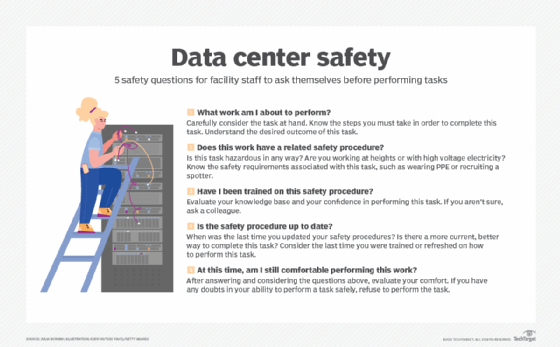
Getty Images
Best practices for data center risk assessment
Data centers contain risks such as height, environmental and electrical hazards. Keep your staff safe by assessing the level of risk and creating a comprehensive safety plan.
High-powered electrical systems that support servers, storage and the facility's environment can present a variety of risks to data center staff. Ensuring employees' physical safety should be the primary goal in any data center. Understanding how to assess and mitigate risk can help both data center owners and data center staff stay safe now and in the future.
Data centers house a range of sophisticated, high-powered electrical and mechanical systems that pose a significant risk of physical harm to staff and the building if not properly managed. Excellent data center safety means prioritizing staff safety and the proper management of hazardous equipment above all else.
Common risks present in a data center facility
The nature of risks in a data center facility can vary from one facility to the next. Consider the following factors during a risk assessment:
- Physical hazards. Power cords and cables around server racks present trip hazards, and open floor panels on raised floors present fall risks.
- Height hazards. Data center facility staff often work at great height on tall racks, roof-based HVAC systems or tall backup generator setups.
- Environmental hazards. Environmental risk factors include excessive heat and cold, as well as loud noise. Staff who remain on site for long periods become susceptible to hyper- or hypothermia and hearing loss. Environmental hazards change based on the time of year, equipment the staff works on and the particular staff involved, but a data center should consider the risks inherent to these factors at all times.
- Facility safety system hazards. Safety systems include fire suppression systems, UPS battery charging methods, backup battery types, fuel storage systems and fuel handling protocol.
- Common procedure risks. Assess staff processes and procedures for risk to ensure staff remain safe at all times. Review such procedures regularly to ensure they still meet guidelines and local safety requirements.
Assessing the risks
Creating a staff risk assessment for data centers requires input from the HR team, on-site staff and the IT team. Each team must follow specific requirements and guidelines and include those in their assessment.
Assigning a dedicated safety leader who is responsible for all safety activities can facilitate coordination between relevant teams. This individual oversees the high-level safety strategy and establishes clear communication about it with staff. This person identifies and develops appropriate safety training programs for staff that follow stated guidelines and internal processes. The safety leader also continually monitors and complies with changing safety standards and practices and conducts regular audits.
Certain areas of the data center have additional, specific safety guidelines that go beyond the basic type of guidelines. These include:
- electricity safety standards for equipment and staff;
- arc flash safety standards;
- hazardous energy lockout or tagout standards;
- physical boundaries for work on electrical systems, such as flash protection, limited approach and restricted approach boundaries;
- fire and environmental storage standards for rechargeable batteries;
- fuel storage and handling for diesel- or gasoline-powered backups;
- fire suppression system standards NFPA 75 and 76; and
- PPE standards for staff when working around hazardous materials such as rechargeable batteries and HVAC systems.
The dedicated safety leader should document the overall strategy and coordinate the development of processes and procedures by relevant parties. However, on-site and IT staff should always participate in documentation efforts as well -- these individuals know the risks inherent to their jobs better than anyone.
Keeping facility staff safe
Safety strategy, process and procedures only work if staff use them. The safety leader or leaders should always document safety information, store that documentation somewhere all staff can access it, update it as needed and hold regular safety meetings and training sessions. Staff at all levels should know the safety protocols in place and feel supported in their ability to refuse any work that appears unsafe.
The safety leader should schedule all safety training and ensure that staff attends. Managers should collaborate with the safety leader to keep appropriate safety measures in place and should participate in any risk assessment update activities.

Staff should always be aware of the safety standards that apply to their work. They should perform any necessary safety assessments before beginning work, such as considering whether a task requires PPE or asking for additional staff to act as safety spotters when working at heights.








